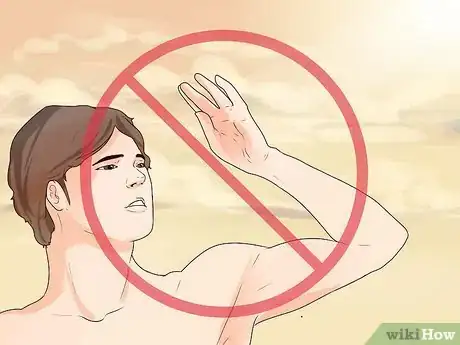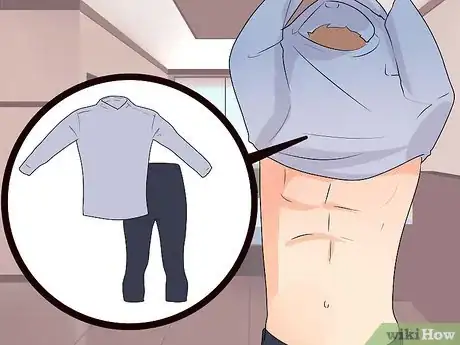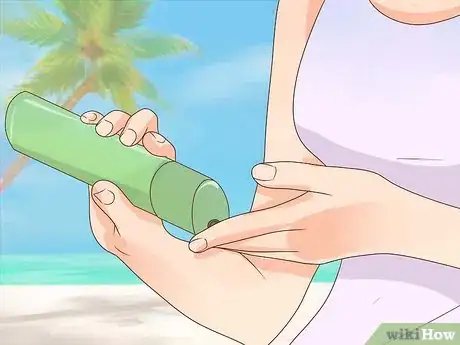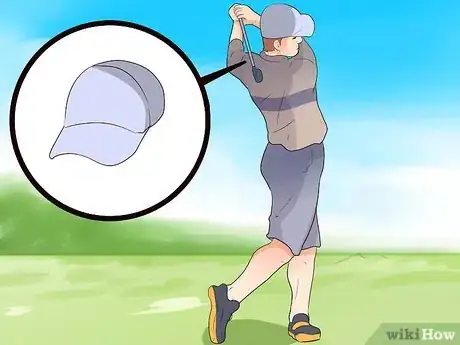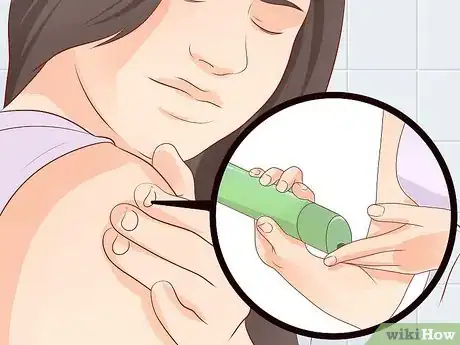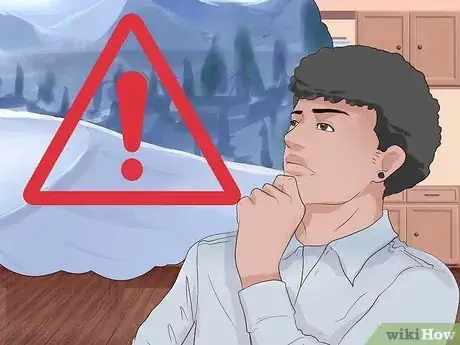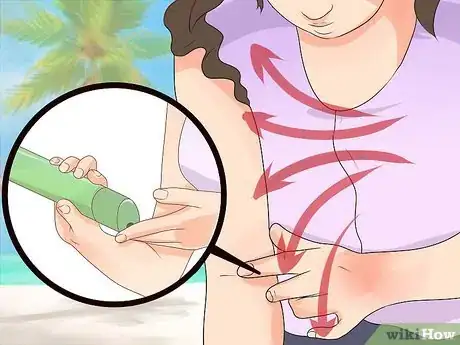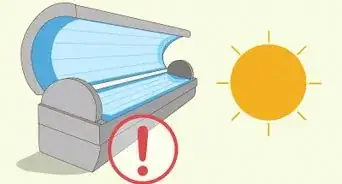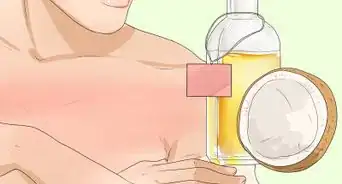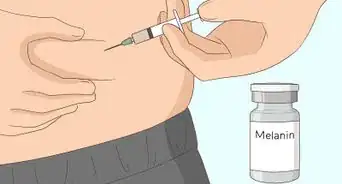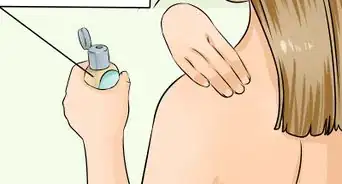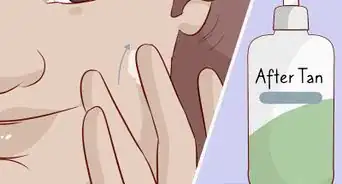This article was co-authored by Kaveri Karhade, MD. Dr. Kaveri Karhade is a board certified Laser, Medical, and Cosmetic Dermatologist in the San Francisco Bay Area. Her areas of expertise are acne and hair loss. She has advanced training in injectables, lasers, surgery, and other cosmetic treatments, and has published extensive research in medical journals. She holds a BS from Michigan State University and a Doctor of Medicine (MD) from the University of Michigan Medical School. She completed her internship in Internal Medicine at New York University School of Medicine and her Residency in Dermatology at Brown University School of Medicine. Dr. Karhade is a fellow of the American Academy of Dermatology and a member of the American Society for Dermatologic Surgery.
wikiHow marks an article as reader-approved once it receives enough positive feedback. This article received 11 testimonials and 100% of readers who voted found it helpful, earning it our reader-approved status.
This article has been viewed 231,891 times.
If you spend a lot of time in the sun, your skin will darken as a result of melanin pigmentation. Some people love going outdoors to get tan, but others try to avoid tanning as much as possible while out and about. While exposure to the sun and its ultraviolet (UV) rays can cause some tanning or sunburn, there are also more dangerous risks caused by excessive sun exposure, including skin cancer, premature aging, and eye damage. Especially during excessive outdoor activities, extra precaution should be taken to help protect you from tanning and overexposure to UV rays.
Steps
Preparing for Outdoor Activities
-
1Avoid periods of peak sunlight. Try to avoid scheduling the activity between the hours of 10 AM and 4 PM when the sun’s UV rays are the strongest. In addition to time of day, also keep in mind that UV rays are more intense:
- At higher altitude
- During the late spring and summer months
- Closer to the equator
- When reflected off of surfaces such as snow, ice, water, sand, and concrete
-
2Wear protective clothing. In tandem with the following steps, protective clothing can be one of the most effective ways to protect yourself from overexposure to UV rays during outdoor activities. The ideal clothing to protect you from the sun includes:
- Bright- or dark-colored fabrics, which have a much higher Ultraviolet Protection Factor (UPF) than light-colored clothing.
- Densely woven, lightweight fabrics. If you can see light through the fabric, this also means that UV light is getting through to your skin!
- Long sleeves and long pants will decrease skin exposure and provide the most protection.[1] If you are wearing shorts, try to wear a longer pair that covers most of the thighs. For shirts, collared shirts can also help protect your neck from tanning.
- Many brands specifically designed for sun protection offer their UPF rating on the label. Seek out a UPF rating of 30 and above for substantial protection from the sun.[2] [3]
Advertisement -
3Wear a hat and sunglasses. The skin on your face and your eyes are very sensitive to sun exposure, so additional precautions must be taken to protect them during outdoor activities. Cover up with extra accessories like hats, sunglasses, and scarves.[4] While many hats and sunglasses will help curb some of the risks, to most effectively reduce exposure risks with the use of a hat and sunglasses, choose:
- A wide-brimmed hat (minimum of 3”), which will keep the sun off of the face, neck (front and back), and ears, as well as any bald spots or parts in the hair. Like protective clothing, the most effective hats will also be made of tightly-woven fabric that you cannot see light through when held up to the sun.
- Sunglasses that provide 100% UV ray protection, particularly models indicating that they provide UVB and UVA protection. Do not assume that dark-tinted lenses provide more protection as light-tinted lenses; it is not the darkness of the lens that indicates its ability to protect the eye from sun damage, and many light-colored lenses provide UVB and UVA protection (if indicated on the label).
- Wraparound sunglasses are even better, as they provide UV ray protection to the entire eye area, including the delicate skin around the eye and the eyelid. By blocking 99 - 100% of UV rays, wraparound sunglasses most effectively help to prevent serious conditions like cataracts and melanomas of the eye.[5]
-
4Use sunscreen. Sunscreen should be used every day to avoid sun exposure risks, but the use of sunscreen to avoid tanning during excessive outdoor activities is an absolute must, even if it is cloudy.[6] The sunscreen can be chemical or physical, as both are effective.[7] When using sunscreen, consider the following for optimum protection:
- Choose a sunscreen that is labeled as “broad spectrum” or “UVA/UVB protection” to shield your skin from both the UVB rays that tan and burn the skin, as well as the UVA rays that penetrate the skin more deeply and cause sun-induced skin aging, called photoaging.[8]
- Choose a sunscreen with a Sun Protection Factor (SPF) of 30 or higher.[9] If you have fair skin, you should consider choosing a higher minimum SPF up to 50.
- Apply 1 ounce (a golf ball-sized amount) of sunscreen 30 minutes before going outside, and then reapply every 2 hours or after swimming, sweating, or toweling off. Even if the sunscreen is labeled as “water-resistant” be sure to reapply often as this does not mean waterproof!
- Be careful to apply sunscreen to your entire body, especially the most commonly missed area like the ears, back of the neck, lips, hairlines, and the tops of feet.
-
5Seek shade whenever possible. Though shade does not block all UV rays, when combined with the other steps listed, shade can help provide relief from the heat and protection from the glare of reflected UV rays. When participating in outdoor activities, seek out areas of natural shade, or create your own shade with an umbrella or tarp to avoid as much UV exposure as possible during peak sunlight hours.
Protecting the Skin During Warm Weather Activities
-
1Wear protective clothing despite the heat. While it may be tempting to wear minimal clothing to beat the heat during outdoor activities in the summer, exposing that much skin to the sun will result in tanning and possibly sunburn. Keep in mind that densely woven, lightweight fabrics will provide protection and shade the skin while running, biking, playing golf, and other outdoor activities.
-
2Consider your surroundings. Depending on the type of outdoor activity you are participating in, different measures can be taken to increase protection against harmful UV rays.
- Golf: With long hours on the course and increased UV reflections from the ponds and sand traps, you experience higher exposure to UV rays. Be sure to always wear a broad-brimmed hat (not a visor or a baseball hat!) and sunglasses, along with long pants or longer shorts and a shirt that minimally covers your shoulders and upper arms.
- Tennis, Running, and Hiking: Due to the excessive perspiration that accompanies these activities, participants are at an increased risk of sweating off their sunscreen. Because of this, reapplication of sunscreen is not enough protection, and clothing and hats with a UPF of 30 or higher are necessary to provide extra defense from prolonged sun exposure.
- Biking: Because of the posture your body is in while riding a bike, the back of the neck, the forearms, and the upper thighs receive much more sun exposure than the rest of the body. To avoid tanning or sunburn during a long bike ride, wear to-the-knee bike shorts, long sleeves, and a wide-brimmed hat and/or cover your neck with the collar of a shirt or a bandana.
- Sailing and Swimming: These activities have some of the highest UV exposure levels due to excessive reflection of UV rays off of the water. In addition to protective clothing and liberal reapplication of sunscreen, sailors and swimmers are recommended to choose sunscreen brands that include zinc oxide or titanium dioxide because they block and reflect UV rays better than other types of sunscreen ingredients that absorb UV rays.
-
3Reapply sunscreen more often than you think. It’s easy to forget to reapply sunscreen when you’re whipping down a bike trail or raising the jib on a sailboat, but sunscreen reapplication is one of the most important ways to prevent tanning during excessive outdoor activity. While the rule for normal activity is reapplication every two hours, be sure to apply more UVA/UVB sunscreen to all exposed skin areas after swimming, sweating, or toweling off.
Protecting the Skin During Cold Weather Activities
-
1Be aware that your skin is at risk even in cold weather. Many people assume that a sunburn or sun tan is only a threat when you feel the hot sun beating down on your skin, but this is not true. In fact, the white snow and ice reflect more UV rays than water, sand, and concrete, so exposed skin is at a higher risk during outdoor winter activities. Do not skip the sunscreen just because you’re not at the beach!
-
2Take extra precaution when in higher altitudes. UV ray exposure increases at higher altitudes, with altitudes of 9,000 - 10,000 feet having 35 - 45% more intense radiation exposure than at sea level.[10] Between the increased UV exposure and the reflection of sun off of the snow and ice, your skin is doubly exposed to UV rays during outdoor winter activities.
-
3Understand the added effects of wind on your sunscreen. While sweat is the main reason for sunscreen wearing away during summer activities, being active outdoors in the winter means you have to contend with sweat, snow, and wind. To safeguard your skin during outdoor winter activities:
- Choose a sunscreen that not only has UVA/UVB protection, but that also has a lot of moisturizer in it to combat windburn. Try to find a sunscreen with ingredients like lanolin or glycerin.
- Don’t forget your lips! The skin on your lips is very delicate and prone to sunburn and windburn, so be sure to also wear a moisturizing lip balm with an SPF of 15 or higher.
- When choosing protective winter clothes and gear, be sure to cover up as much skin as possible; wear a hat, gloves, balaclava or light-weight scarf for face and neck protection, and sunglasses or goggles that offer UV protection. A ski mask with UV protection is an especially prudent choice, as it covers much of the face.
Expert Q&A
Did you know you can get expert answers for this article?
Unlock expert answers by supporting wikiHow
-
QuestionWhat sunscreen should I use?
 Kaveri Karhade, MDDr. Kaveri Karhade is a board certified Laser, Medical, and Cosmetic Dermatologist in the San Francisco Bay Area. Her areas of expertise are acne and hair loss. She has advanced training in injectables, lasers, surgery, and other cosmetic treatments, and has published extensive research in medical journals. She holds a BS from Michigan State University and a Doctor of Medicine (MD) from the University of Michigan Medical School. She completed her internship in Internal Medicine at New York University School of Medicine and her Residency in Dermatology at Brown University School of Medicine. Dr. Karhade is a fellow of the American Academy of Dermatology and a member of the American Society for Dermatologic Surgery.
Kaveri Karhade, MDDr. Kaveri Karhade is a board certified Laser, Medical, and Cosmetic Dermatologist in the San Francisco Bay Area. Her areas of expertise are acne and hair loss. She has advanced training in injectables, lasers, surgery, and other cosmetic treatments, and has published extensive research in medical journals. She holds a BS from Michigan State University and a Doctor of Medicine (MD) from the University of Michigan Medical School. She completed her internship in Internal Medicine at New York University School of Medicine and her Residency in Dermatology at Brown University School of Medicine. Dr. Karhade is a fellow of the American Academy of Dermatology and a member of the American Society for Dermatologic Surgery.
Board Certified Dermatologist
-
QuestionWhat clothes should I wear to protect my skin?
 Kaveri Karhade, MDDr. Kaveri Karhade is a board certified Laser, Medical, and Cosmetic Dermatologist in the San Francisco Bay Area. Her areas of expertise are acne and hair loss. She has advanced training in injectables, lasers, surgery, and other cosmetic treatments, and has published extensive research in medical journals. She holds a BS from Michigan State University and a Doctor of Medicine (MD) from the University of Michigan Medical School. She completed her internship in Internal Medicine at New York University School of Medicine and her Residency in Dermatology at Brown University School of Medicine. Dr. Karhade is a fellow of the American Academy of Dermatology and a member of the American Society for Dermatologic Surgery.
Kaveri Karhade, MDDr. Kaveri Karhade is a board certified Laser, Medical, and Cosmetic Dermatologist in the San Francisco Bay Area. Her areas of expertise are acne and hair loss. She has advanced training in injectables, lasers, surgery, and other cosmetic treatments, and has published extensive research in medical journals. She holds a BS from Michigan State University and a Doctor of Medicine (MD) from the University of Michigan Medical School. She completed her internship in Internal Medicine at New York University School of Medicine and her Residency in Dermatology at Brown University School of Medicine. Dr. Karhade is a fellow of the American Academy of Dermatology and a member of the American Society for Dermatologic Surgery.
Board Certified Dermatologist
Warnings
- Be sure to check the labels of medications you are taking, as certain oral and topical medicines can increase skin and eye sensitivity to UV rays. Some cosmetics can also affect your skin’s sensitivity to sun exposure, so be sure to look at all sun alert statements on product labels, especially for products containing alpha hydroxy acids.⧼thumbs_response⧽
References
- ↑ Kaveri Karhade, MD. Board Certified Dermatologist. Expert Interview. 5 January 2021.
- ↑ Kaveri Karhade, MD. Board Certified Dermatologist. Expert Interview. 5 January 2021.
- ↑ http://www.skincancer.org/prevention/sun-protection/prevention-guidelines/preventing-skin-cancer
- ↑ Kaveri Karhade, MD. Board Certified Dermatologist. Expert Interview. 5 January 2021.
- ↑ http://www.skincancer.org/prevention/sun-protection/prevention-guidelines/preventing-skin-cancer
- ↑ http://www.surgeongeneral.gov/library/calls/prevent-skin-cancer/exec-summary.html
- ↑ Kaveri Karhade, MD. Board Certified Dermatologist. Expert Interview. 5 January 2021.
- ↑ http://www.skincancer.org/prevention/sun-protection/prevention-guidelines/preventing-skin-cancer
- ↑ Kaveri Karhade, MD. Board Certified Dermatologist. Expert Interview. 5 January 2021.
About This Article
To prevent tanning during excessive outdoor activities, avoid being outside between 10 AM and 4 PM when UV rays are most intense, if you can. If you can't, make sure to wear protective clothing like a hat and a long-sleeved shirt. Be sure to apply sunscreen that has both UVA and UVB protection to any exposed skin and reapply often, at least every 2 hours. Even in colder temperatures, seek shade whenever possible. To learn how to take care of your skin at high altitudes, scroll down!
